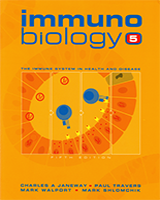By agreement with the publisher, this book is accessible by the search feature, but cannot be browsed.
NCBI Bookshelf. A service of the National Library of Medicine, National Institutes of Health.
Janeway CA Jr, Travers P, Walport M, et al. Immunobiology: The Immune System in Health and Disease. 5th edition. New York: Garland Science; 2001.

Immunobiology: The Immune System in Health and Disease. 5th edition.
Show detailsLymphocyte antigen receptors, in the form of immunoglobulins on B cells and T-cell receptors on T cells, are the means by which lymphocytes sense the presence of antigens in their environment. The receptors produced by each lymphocyte have a unique antigen specificity, which is determined by the structure of their antigen-binding site, as described in Chapter 3. Because each person possesses billions of lymphocytes, these cells collectively provide the individual with the ability to respond to a great variety of antigens. The wide range of antigen specificities in the antigen receptor repertoire is due to variation in the amino acid sequence at the antigen-binding site, which is made up from the variable (V) regions of the receptor protein chains. In each chain the V region is linked to an invariant constant (C) region, which provides effector or signaling functions.
Given the importance of a diverse repertoire of lymphocyte receptors in the defense against infection, it is not surprising that a complex and elegant genetic mechanism has evolved for generating these highly variable proteins. Each receptor chain variant cannot be encoded in full in the genome, as this would require more genes for antigen receptors than there are genes in the entire genome. Instead, we will see that the V regions of the receptor chains are encoded in several pieces—so-called gene segments. These are assembled in the developing lymphocyte by somatic DNA recombination to form a complete V-region sequence, a mechanism known generally as gene rearrangement. Each type of gene segment is present in multiple copies in the germline genome. The selection of a gene segment of each type during gene rearrangement occurs at random, and the large number of possible different combinations accounts for much of the diversity of the receptor repertoire.
In the first two parts of this chapter we will describe the gene rearrangement mechanism that generates the V regions of immunoglobulin and T-cell receptor genes. The basic mechanism is common to both B cells and T cells, and involves many if not all of the same enzymes. We will describe the details of the enzymology of this recombination process, the evolution of which was probably critical to the evolution of the vertebrate adaptive immune system.
In B cells, but not T cells, the rearranged V region undergoes additional modification, known as somatic hypermutation. This does not occur until after B cells encounter and become activated by antigen. In these cells, the V regions of the assembled immunoglobulin genes undergo a high rate of point mutation that creates additional diversity within the expanding clone of B cells responding to antigen.
In the third part of the chapter we consider the limited, but functionally important, diversity of immunoglobulin C regions. The C regions of T-cell receptors do not show such diversity as they function only as part of a membrane-bound antigen receptor. Their role is to anchor and support the V regions at the cell surface as well as linking the binding of antigen by the V regions to the receptor-associated intracellular signaling complex. The C regions of immunoglobulins also serve these functions but in addition the C regions of the heavy chain are responsible for the effector functions of the secreted immunoglobulins, or antibodies, made by activated B cells. These CH regions come in several different versions, or isotypes, each of which has a different effector function. In B cells that have become activated by antigen, the heavy-chain V region can become associated with a different CH region by a further somatic recombination event, in the process known as isotype switching. This enables the different heavy-chain C regions, each with a different function, to be represented among antibodies of the same antigen specificity.
Contents
- The generation of diversity in immunoglobulins
- T-cell receptor gene rearrangement
- Structural variation in immunoglobulin constant regions
- Summary to Chapter 4
- General references
- Section references
- The Generation of Lymphocyte Antigen Receptors - ImmunobiologyThe Generation of Lymphocyte Antigen Receptors - Immunobiology
Your browsing activity is empty.
Activity recording is turned off.
See more...